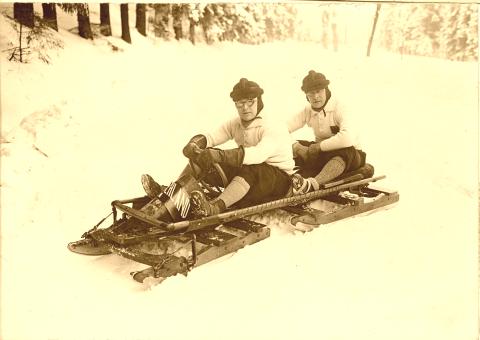Your Cart is Empty
Sold Out
Antique Flexible Flyer Snow Sled
Airline Cruiser
c. 1930’s – 1940’s, 20th century
Wood, metal
65"l x 26"w x 8"h
© Vintage Winter
This is one of the largest Flexible Flyer models. It is currently in very good condition with a very natural wood patina. There are some white paint “flecks” on this sled. (likely easily removable with mineral spirits).
The Flexible Flyer sled was invented over 100 years ago. The Flexible Flyer trademark has enjoyed lasting name recognition among children (and their beleaguered parents) which few other products can match. The technical superiority of the patented design remains unequaled to this day, at least among sleds of the twin runner type. It is an ideal example of how a strong trademark can indelibly identify a product in the minds of consumers, and of how a patented design can distinguish one product over its competitors.
Samuel Leeds Allen, the inventor of the Flexible Flyer, came from a prominent Philadelphia Quaker family. In the 1860s, he established the S. L. Allen Co. to manufacture farm equipment, including some items of his own invention. In order to diversify his product line and provide work during the winter months, Allen, himself a “coasting” enthusiast since boyhood, set about inventing a sled. Typical designs of the day employed a pair of fixed wooden runners with a third, pivotable steering runner attached to a handle. Allen first experimented with articulated sleds having two or more “bobs” with fixed runners that could pivot relative to each other to provide steering.
Eventually, he conceived of a sled with runners that were weakened in the middle to act as a hinge to permit the front portion to pivot for steering. This led to the design which became the Flexible Flyer with “super steering”-a sled with a pair of laterally flexible runners attached to the frame in a way that permitted them to be bent sideways to a great extent and with little effort. He accomplished this by attaching the front pair of runner struts to a crossbar which floats (is not attached) relative to the seat. This permits the runners to flex sideways starting at a point just ahead of the rear struts. A conventional sled lacking this floating crossbar arrangement has runners that can thus only flex forward of the front struts, severely limiting the steering capability of the sled.
The Flexible Flyer trademark has proven to have as much lasting value as the Allen patent. A good trademark should roll off the tongue, lodge permanently in the brain, and be suggestive or fanciful (a phrase which is merely descriptive cannot, as a rule, be registered as a trademark). Flexible Flyer is a hit on all three counts; it is short enough and employs alliteration to make it pleasing to say and easily remembered. “Flyer” connotes the speed associated with sledding. “Flexible” conveys the unique technical feature of the sled’s superior steering. It is hard to imagine a trademark more suited to the product it represents.
The Flexible Flyer has remained essentially unchanged in design and construction over the decades. It still features wooden seat slats bearing the distinctive red eagle trademark, wooden steering and handle bars, and steel runners and struts painted bright red. It is hard to understand why no competitor has ever (to my knowledge) attempted to copy Allen’s design, even though his patents have long since expired. Perhaps the Flexible Flyer trademark has been so strongly associated with the design for so long that the buying public cannot imagine any sled with the patented “super steering” feature which is not a Flexible Flyer.
